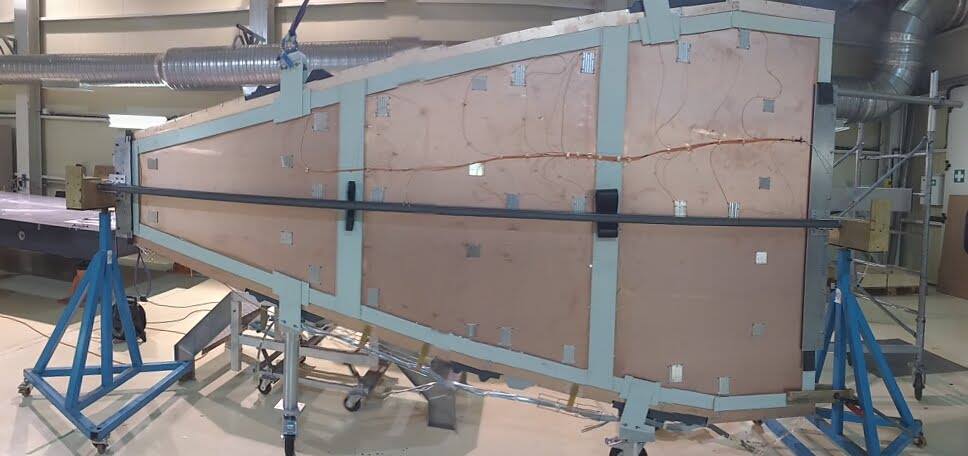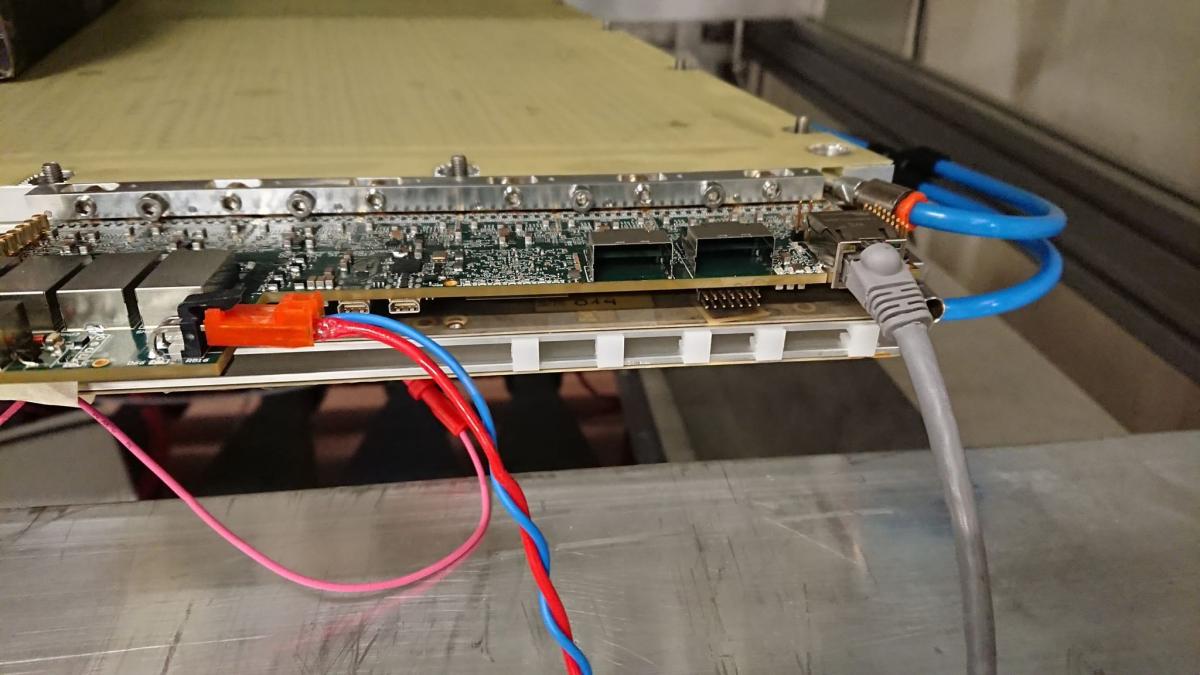A New Small Wheel for ATLAS is taking shape
In order to fully exploit the HL-LHC luminosities, the innermost stations, the so called Small Wheels (SW), of the ATLAS Muon Spectrometer need to be replaced, by two new detector assemblies called New Small Wheels (NSW). This upgrade is schedule to take place in LS2 (at least for sides A based on the current schedule). This sets one of the largest challenges for the phase 1 upgrade project of the ATLAS Muon System to be installed during the LHC long shutdown in 2019/20.
Figure 1: A z-y view of 1/4 of the ATLAS detector. The blue boxes indicate the end-cap Monitored Drift Tube chambers and the yellow box in the Small Wheel area the Cathode Strip Chambers (CSC). Green boxes are barrel MDT chambers. Trigger chambers, Resistive Plate Chambers (RPC) and Thin Gap Chambers (TGC) are indicated by the outlined white and magenta boxes. This is a cut-out of the muon spectrometer at the large sectors, hence the names "End-cap Inner Large" (EIL), "End-cap Middle Large" (EML) and "End-cap Outer Large" (EOL). The detector regions of the Small Wheel and Big Wheel are also outlined.
The New Small Wheel (NSW) will have to operate in a high background radiation region (counting rates up to 15 kHz/cm2 ) while reconstructing muon tracks with high precision as well as furnishing information for the Level-1 trigger. A very clear indication of the origin of the triggered muon is necessary and will be provided by the NSW. These performance criteria are demanding. In particular, the precision reconstruction of tracks for offline analysis requires a spatial resolution of about 100 µm, and the Level-1 trigger track segments have to be reconstructed online with an angular resolution of approximately 1 mrad.
![]()

Figure 2: Two views of the shielding disk (NJD) which will support the chambers, in b191, shown with and without scaffolding, and with services routed around its periphery.
The ATLAS NSW has two detector technologies, Micromegas (MM) and small strip Thin Gap Chambers (sTGC), which both provide tracking and triggering capability, and thus a very high level of redundancy. The small strip pitch, 0.5mm for the MM and approx. 3.5mm for sTGC provide exceptional tracking precision capabilities up to very high background rates.
Such a precision is crucial to maintain the current ATLAS muon momentum resolution in the high background environment of the upgraded LHC. In addition, sTGC have excellent timing resolution and can provide bunch crossing identification, while both sTGC and MM chambers can, at the same time, confirm the existence of track segments found by the muon end-cap middle station (Big Wheels) online.
A unique challenge for the Micromegas build for ATLAS upgrade is the larger dimension compared to other experiments and previously built such detectors. The realization of the ATLAS NSW requires the production of large size MM with a surface of about 3 m2, The design and the construction procedures for the NSW Micromegas are the result of detailed studies for each single element which comprises the chamber with extensive prototyping and tests, taking into account different mechanical simulation models. The detectors have trapezoidal shape and are arranged in quadruplets, with 4 layers each, in order to provide four independent points; the readout planes are disposed in a “back-to-back” configuration onto two stiffening panels with an aluminum honeycomb internal structure. Two readout planes are equipped with strips parallel to the bases of the trapezoid for the measurement of the precision coordinate while on the other two the strips are alternatively inclined to provide the second coordinate.
During an intense R&D phase, in collaboration with EP’s D&T group, small and medium size single layer prototypes have been constructed. In 2013 two large working prototypes with a single readout layer have been built at CERN laboratories in order to prove the ability to construct large size MM with the adequate mechanical precision. An important step in the prototype developed of the MM was the construction in spring 2014 of the first quadruplet with dimensions of 1.2 x 0.5 m2 in a configuration very close to the final one chosen for the NSW. In order to demonstrate the performance characteristics of the MM technology and also to optimize the design and operational characteristics of the detector, several prototypes have been tested with high energy particle beams. The studies included testing of chambers of various sizes with different characteristics in different beam environments. Lessons learned during the production of this prototype have been used in the design of the final modules and are essential for establishing the procedures of construction and assembly.
In the previous month, the New Small Wheel structures have taken shape in building 191, with both mechanics and services installation well advanced. All parts of the so called new JD, the shielding disk made of iron have been received. The JD serves as the support for the New Small Wheel detectors, but also for shielding the end-cap muon chambers from hadrons. Following that, the structure spokes also arrived over the summer, taking their place on the new JD, one by one. They will serve as support for the assembled detectors. Meanwhile, the services team is installing numerous cables and pipes on the disk, in a very confined space. Only a few millimetres can be used between the disk and the chambers for the cables on one side. Only a few millimetres can be used between the disk and the calorimeter on the other side. Having to work from an elevating platform makes it even more challenging. Of course, inside every spoke, there is an alignment bar, equipped with cameras, establishing contact with each other, soon to be looking between and onto the detectors, in order to mark the real positions of each chamber with sub-millimeter precision.

Figure 3: A fiber connection panel at the edge of the wheels.
In building 180, sTGC chambers are prepared, following several steps that include alignment on a flat granite table, glueing a frame on both sides to create a wedge. Once a wedge is in hands, the adapter boards, Faraday cages, cables, pipes, cables trays and the rest of front-end electronics are mounted. All procedures and tools have been defined and are available and ready for accepting chambers as they arrive.

Figure 4: Three sTGC quadruplets assembled in a wedge, with alignment fibers routed on the surface
A bit further in the countryside, in building 899 (BB5), the integration site for the Micromegas chambers lies. Similar to the sTGC, the chambers arriving will be positioned and aligned, to be assembled into wedges, on a common middle support. On a daily basis, cables arrive to be assembled with connectors, and tested; piping cut to length, cleaned and protected until installation; gas leak and high voltage test stations are employed for quality control. The ensemble is completed with a cosmics test stand, to be used as a final quality check before shipping the Micromegas to building 191 for assembling with the sTGC.

Figure 5: A Micromegas test Front-end board mounted on the chamber
Back to the Meyrin site, a slice of the New Small Wheel electronics is developed, as a base to establish all connections and interfaces between the boards, and further develop the system. The New Small Wheel custom ASICs are in their final stages. The front-end read-out chip, VMM, went through its Production Readiness Review in October of 2018 after the final improvements with version 3a, while the rest of companion chips (ROC, TDS, ART) have already been produced in quantity and are undergoing packaging. The corresponding front-end boards are also closing in on their own production. The Micromegas one (version 319) is equipped with the final ASICs and currently undergoes some final checks with respect to grounding and noise. The sTGC one (version 2.3) is on a similar path.

Figure 6: The SM2 module 1 at CERN's North Area, tested under beam.
A lot of activity is ongoing also in the Prevessin side. The teams are testing chambers either with the SPS extraction line hadron beams, or at the Gamma Irradiation Facility (GIF), located in the same building. Over the summer, a Micromegas module (type SM2) was tested at the H8 area, in order to study performance under different rates and different gases, to further understand the micro-TPC reconstruction used for inclined tracks, and to define a safe high voltage working point for the chambers. The sTGC also carefully studied trigger performance and chamber efficiency on their chamber (type QL1), but also tested in GIF their tracking capabilities with the high uncorrelated background rate (type QS3).
At the construction sites, in Italy, Germany, Russia/Greece and France, for the Micromegas, and Chile, Canada, Israel, Russia and China, for the sTGC, the construction and assembly of chambers is happening. The Micromegas community has been tackling HV stability issues in the beginning of the year. Over the summer, a production module equipped with near final electronics was tested in the North Area, to define the right operating point, while trying to maintain good resolution and efficiency, while the effect of a lower working point in ATLAS performance was evaluated with Monte Carlo.
Figure 7: Physicists working in Saclay to connect a Micromegas module (left) and the proud team in Thessaloniki, Greece, ready to ship drift panels to Dubna for assembly (right).
In parallel, further studies on the mesh choice, and looking into optimising the gas choice, were carried out. A great effort, leading to a combined review of panel cleaning and operating procedures, as well as long term stability. This resulted in resuming production of series chambers during this Fall. And so, both technologies having entered series production, while all infrastructure is revving, all procedures and schedules are optimised to accommodate to the Long Shutdown planning.
The first New Small Wheel is scheduled to enter the ATLAS cavern in Spring of 2020. A lot of progress has been achieved, with many important milestones ahead; the fruits of labor from a strong collaboration.
Note: The authors would like to warmly thank Stephanie Zimmermann, project leader of the ATLAS NSW upgrade, for her thoughftul comments on this article.
